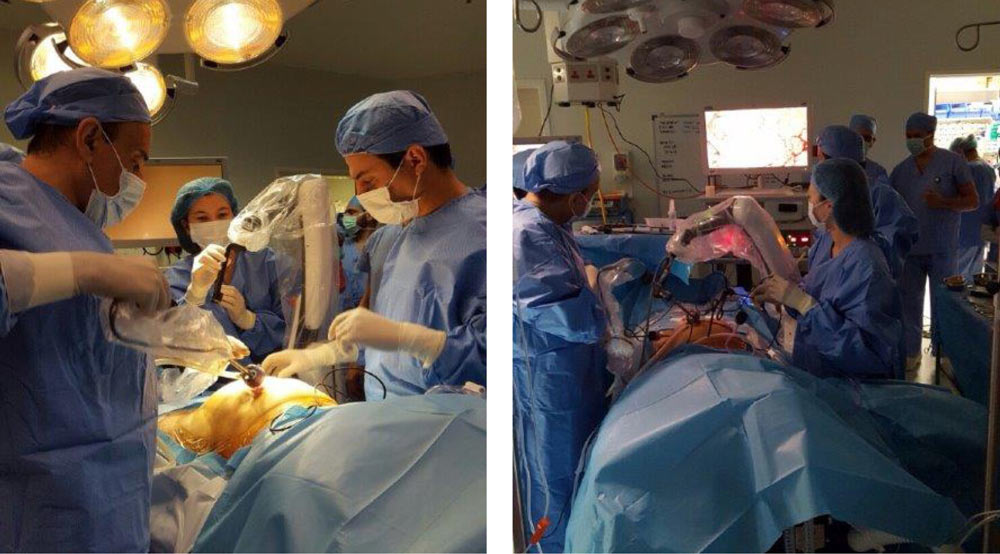A Rare and Successful Surgery Al-Ahli Hospital Eradicates a Giant Splenic Cyst
 By Abdul-Azim Abdul-Wahab, Senior Consultant Surgeon & the Chief of the medical staff at Al-Ahli Hospital / Qatar
By Abdul-Azim Abdul-Wahab, Senior Consultant Surgeon & the Chief of the medical staff at Al-Ahli Hospital / Qatar
Al-Ahli Hospital recently performed a successful operation to remove a giant splenic cyst; a scarce and rare case in the field of surgery.
Dr. Abdul-Azim Abdul-Wahab, a senior consultant surgeon and the chief of the medical staff at Al-Ahli Hospital, said that the 56-year-old patient went to a private hospital in Doha complaining from chronic pains in the back after experiencing severe pains.
He explained that the patient also suffered from chronic hypertension, hyperlipidemia, and hypothyroidism. He was taking drug on a regular basis for all these chronic diseases. Upon an abdominal C.T, it was found that he has a splenic cyst as large as 10 cm x 10 cm with a 9-cm left kidney cyst. He pointed out that the patient visited the urology clinic at Al-Ahli Hospital and was assessed in terms of the left renal cyst. He was given the necessary directions and advice regarding it. He was advised that it doesn’t need a surgical intervention, as it is a simple renal cyst.
Accordingly, the patient was referred to the general surgery clinic at Al-Ahly Hospital where he was clinically assessed by Dr. Abdel-Azim Hussein who advised him to have a surgery for removing the splenic cyst due to its large size and the accompanying symptoms.
He noted that the reaction of parasitic cysts in the patient was found to be negative. Accordingly, the possibility that this cyst is a parasitic-origin splenic one was excluded. Thereafter, the patient received the necessary preventive vaccinations about 2-3 weeks before the splenic surgical intervention.

Dr. Abdul Azim Hussain said “The patient was operated on 2 November 2020. It started with a laparoscopic surgery, where the investigation of the abdominal cavity showed a giant cyst (acromegalic), occupying most of the spleen tissue and large areas of the cyst wall were found severely calcified causing severe adhesions to the neighboring organs, including the stomach, colon and diaphragm. Thus, a laparotomy was performed instead due to the inability to perform the excision by laparoscopic surgery because of the severe adhesions of the splenic cyst to the neighboring organs. The cyst was successfully isolated from the neighboring structures and was removed completely, along with the remainder of the relatively little splenic tissues”.
“The patient recovered well and quickly after the surgery, and was discharged from Al-Ahli Hospital on the third day in a good general condition with almost no complications”.
He pointed out that the result of the autopsy showed that the splenic cyst is of the type of Giant Splenic Pseudocyst. The existence of this type of giant splenic cysts are scarce and rare and, scientifically speaking, splenic cysts are a very rare clinical case that occurs in about 0.07% of the total population.
He explained that patients with splenic cysts, in general, do not show any specific clinical symptoms, and that these cysts are often accidently discovered during the radiological examination. Ultrasound, CT and magnetic resonance imaging can be used for the initial diagnosis.
Splenic cysts are classified into parasitic cysts and non-parasitic cysts, while non-parasitic splenic cysts are classified into pseudocysts and true cysts. True splenic cysts are those containing an epithelial lining (superficial epithelium). Pseudocysts do not contain epithelial lining (superficial epithelium) and are usually formed after trauma, inflammation, or partial splenic infarction.
Splenic pseudocysts are very rare. They are found in less than 1% of splenectomies performed. However, pseudocysts in the spleen are four times more common than true cysts. In 1829, Andral described the first non-parasitic cyst in the spleen.
In 1978, Robbins reported a series of 42,327 autopsies over a 25-year period, which revealed only 32 patients with splenic cysts, In 1953, Fowler published a collective review to include 265 cases of non-parasitic splenic cysts.2
Until 1978, nearly 600 surgical and cyst autopsy cases were reported in the global literature. It is important to distinguish between splenic pseudocysts and other benign and malignant splenic cysts, including parasitic hydrocysts, in order to follow the appropriate course of treatment. Typically, splenic pseudocysts show no symptoms and rarely grow to a large size and only require treatment when they become symptomatic. Typically, only large cysts are symptomatic, and they are surgically treated by removing the spleen. They only require surgery when symptoms appear and, in such cases, the chances of preserving the spleen are usually less.
















